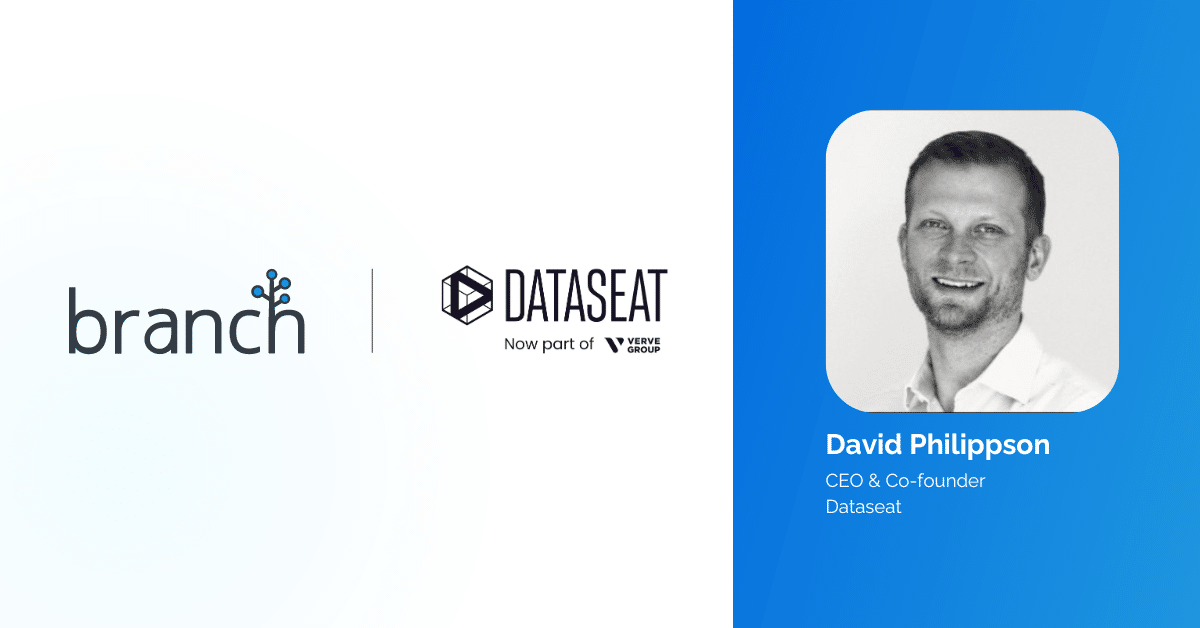While the industry is rife with rumors and hyperbole, it’s rare to get an honest source of what’s happening on the ground in the post-ATT world. One of my longtime friends, David Philippson, is a rare exception. As a veteran in the industry of adtech, he’s not afraid to share an unfettered — and sometimes unflattering — view of the industry today. I sat down and asked him to share what the forward-looking leaders are doing — and how they’re planning to prepare for the inevitable future of post-privacy measurement.
In this blog, we’re just touching the surface of David’s advice and predictions. If you like this take, connect with him on LinkedIn and let us know. We’ll be inviting David back for a webinar and we’d love to hear some of your questions.
Also, take a look at previous “From the Trenches” takes where the popular app Picsart gives actionable advice on how to approach SKAdNetwork. If you’re looking for even more practical advice, check our advice on approaching aggregate privacy-centric measurement or our strategies for setting the optimal conversion values.
— Adam Landis, Head of Growth at Branch
I’ve known you for over a decade and you’re well-known in the esoteric circle of adtech pundits, but can you share a little about your background in the industry with the folks who you haven’t yet met?
My name is David Philippson and I am the CEO and co-founder of Dataseat, a transparent contextual DSP built for a privacy-complaint, device ID-less world. Dataseat was acquired by Verve Group in July 2022.
Prior to Dataseat, I founded what was arguably the first mobile measurement partner (MMP)/attribution business called AD-X Tracking. AD-X was acquired by Criteo in 2013, and then I spent the following four years building the Criteo in-app retargeting business.
I am also an investor and advisor to many mobile adtech startups, including Luna Labs (acquired by ironSource), Aequus (acquired by Moloco), and Ad-Lib.io (acquired by Smartly.io).
So you’re experienced enough to know that adtech is a tough business. Yet you decided to found another DSP at — arguably — the height of competition. Can you tell us a little about the background of how Dataseat came to be?
While I was at Criteo, Apple made their first significant move to improve privacy through the rollout of ITP (intelligent tracking prevention) 1.0 and 2.0, which limited the duration of first- and third-party cookies in the Safari browser. I’d spent the previous seven years studying and second-guessing what Apple’s next moves might be and developed the hypothesis that ITP was a precursor to IDFA deprecation in iOS.
The majority of user acquisition (UA) app performance up until that point had been driven by behavioral bidding based on user profiles — where ad networks would collect IDFAs from advertisers and publishers alike, giving them a detailed view of the apps used by individual consumers. This naturally gave them the ability to do very effective behavioral advertising.
Most thought we were a little crazy starting a DSP in 2019, but our thesis was that if IDFA disappeared, most large ad networks that dominate today would be seriously disrupted. This created an opportunity for a new entrant DSP built from the ground up and focused on driving performance with contextual signals — without any reliance on IDFA or similar device IDs.
We were one of the only adtech companies celebrating when ATT was announced and have since developed advanced SKAN-only optimization strategies. We are proud to boast some of the world’s largest privacy-conscious brands as our clients.
So you predicted a future of major upheaval and then ran toward it. I can see why they thought you were crazy. Your thesis came to be, and now you focus on privacy-centric advertising. Walk us through your advertising clients. Who are you working with today?
When we started Dataseat, we were entirely focused on iOS UA for gaming companies. That was a strategic commercial decision to focus on this narrow beachhead, since by doing so we thought ourselves more likely to succeed in that total addressable market (TAM). I’m proud to claim some of the world’s biggest gaming companies as our clients, including Playtika, Jam City, and Rovio. Since then, and after becoming part of Verve Group, we have widened our focus to include all brands that want to drive performance through app user acquisition, and we are delighted to now be working with some of the most well-known consumer brands.
Technically speaking, our machine learning and optimization models don’t need to know the difference between conversions — it could be a burger order for one client or a music subscription for another. Because of that, many of our advancements for gaming clients were immediately applicable to our more recent non-gaming brand segment.
I don’t think most people in the market know how much most folks are struggling with SKAN today. Can you tell us what you’re seeing in the market?
The ugly truth is, the majority of gaming clients continue to use fingerprinting (aka probabilistic matching) and are ignoring SKAN. Conversely, many non-gaming clients are attempting to embrace SKAN but struggle to see the performance of their spend.
I think the majority of ad networks are continuing to optimize their campaigns with probabilistic signals and are ignoring the harder, more complex route of SKAN-only tracking.
Of the advertisers that are making the right decisions and investing in SKAN, many are struggling to see performance as a result — which is mostly due to the ad networks’ lack of investment and adoption of SKAN. It is presumably incredibly hard for a multi-billion-dollar ad network with thousands of employees and processes to pivot all of their resources to SKAN, which can be incredibly complex and usually requires a custom solution per advertiser. The ad networks just aren’t set up to easily deliver what is required.
I agree, we’ve seen very little practical advice from the large advertisers, and I’ve seen many folks languishing in the unknown. So your clients are all using SKAN. How are they going about it?
More sophisticated clients are working closely with us and sharing their 6-bit conversion strategy, allowing us to contribute and advise them on the best approach to using coarse-grained vs. fine-grained conversion values. They have typically stopped fingerprinting with their MMPs and are measuring success with SKAN through their MMP dashboards. Almost all have continued to value their MMP’s SKAN reporting capabilities.
Typically, these clients have a very close relationship with us and regular dialogue that allows us to understand and customize our Campaign ID strategy (now called Source Identifier in SKAN 4) to suit their exact needs. For example, one of our clients may be running in two tier-1 countries, running 30-second video ads with five different creative iterations, and spending $300k per month. Meanwhile, another client may be running in 10 countries — all tier-1 and running over 50 different iterations of video, banner, and interstitial — but are spending less, and are therefore more affected by privacy thresholds. For each client, we created a completely different implementation of our Campaign IDs/Source Identifiers that balances privacy thresholds while gaining as much data as possible from SKAN conversions.
There’s a ton of speculation on how to best prepare for SKAN 4.0. And most of the advice SHOULD be coming from the ad platforms, since your methods of targeting and optimization have the largest impact on campaign performance. What are telling your clients to prioritize when starting to plan? And what do you think is most important for them to understand and clarify?
First, we’re making sure the app is SKAN 4-compatible and submitted to the app store.
For conversion values, you should determine the best use of fine- and coarse-grained IDs based on your own data and on how the advertiser differentiates between predicted lifetime value (LTV). Distinctions between low vs. higher payers are particularly important. For example, putting all payers in the high-conversion value bucket may make it impossible to optimize toward finding particularly high-IAP users later on.
Invest time in understanding a typical user profile and which publishers represent the strongest affinity to your users’ base. In a privacy-complaint, contextual world all campaigns will run on targeted, approved publishers that have been intentionally selected due to their contextual relevance to the advertiser (e.g., BMW advertising in the Financial Times).
Spend time with ad network partners to understand their optimization strategy. Ask them specifically what their Campaign ID strategy will be for your campaign requirements, and how this may differ from their default approach. If they can’t answer that, you are not working with a partner that can effectively navigate these challenges with you.
Okay, this is all very complex and frankly most folks just tune out. What’s the bottom-line advice you’d give to advertisers?
Don’t be complacent. Some advertisers think they will be able to fingerprint iOS users forever, but I strongly believe that Apple will enforce SKAN and stop fingerprinting this year, or when SKAN 4 adoption is above 50%.
Interesting, that’s a bold prediction. When will this happen?
I predict SKAN 4.0 adoption within publishers at 50% by Q4 2023 — a bit slower than we originally anticipated due to the fact that the majority of advertisers aren’t relying on SKAN yet, so the pressure on SSPs to upgrade has been lower than expected.
This will be shortly followed by enforcement through some high-profile App Store rejections. I do not think enforcement will be via rollout of Private Relay to in-app traffic.
I expect further enhancements to SKAN via SKAN 5 discussed at WWDC in June:
- GEO or country code may be added to SKAN postback, most likely subject to a privacy threshold.
- Privacy thresholds reduced for some of the smaller publishers to make it fairer, allowing smaller apps to remain visible in conversions despite having less crowd anonymity vs. larger players.
Ready for privacy-focused, accurate attribution data at your fingertips? Request a demo.




